Fiesta Informacion 2004: Continuing the Transformation Journey
Military, government and industry experts gathered at the AFCEA Alamo Chapter’s Fiesta Informacion 2004 in April to present their perspectives on the transformation—its successes, problems and evolving requirements. During the three-day symposium, more than 2,300 registrants heard panels addressing interoperability, security, collaboration, and integration issues and challenges.
Gen. John P. Jumper, USAF, chief of staff, U.S. Air Force, kicked off Fiesta Informacion 2004 during his keynote luncheon speech by challenging industry “to give him ideas and solutions.” He stressed that he wanted “IT ahead of its time to help put the cursor over the target.”
Focusing on interoperability, experts for the first day’s panel discussion, agreed that achieving “commonality” among systems for data sharing is a pervasive problem. Lt. Gen. Robert Shea, USMC, director, command, control, communications and computer systems, J-6, the Joint Staff, who led the panel, said interoperability is still an issue many organizations need help addressing, particularly with respect to large data volumes and disparate data sources. “Who owns the data? How is it validated? What are the rule sets that verify it as authoritative amongst all the data that will be posted? We still need to work through this issue,” Gen. Shea warned. In this effort, “the Office of the Undersecretary of Defense for Intelligence (OUSD-I) is crystallized on interoperability at the data layer … so that intelligence data can be posted for timely discovery,” according to Kevin Meiners, director of intelligence strategies, assessments and technology, OUSD-I.
The second-day’s keynote luncheon speaker, Lt. Gen. Michael Hayden, USAF, director, National Security Agency (NSA), focused on what he calls “transformation 2.0” at the NSA. He emphasized the importance of teaming with other parts of the intelligence community, with allies, with their clients, within the NSA and with others.” He discussed sharing information at the earliest point of consumability and noted that today it seems to be in the translation, analysis, and dissemination stages. “This is our shared analytic space where we have our collaborative target development, not in the access, collection and processing stages,” he explained.
On day two, Lt. Gen. Keith Alexander, USA, deputy chief of staff, G-2, Headquarters Department of the Army, moderated the security panel and noted the breadth of the challenge in transnational programs. In addition, he pointed out that there is a great need for a capability to quickly look at all data regardless of classification. Mel Mireles, director, enterprise operations, state of Texas Department of Information Resources, stressed that “all levels of government need to be sharing information. He warned, “We must know what the vulnerabilities are and how they are being corrected—by whom and how quickly?” Summing up the security session, General Dynamics Advanced Information Systems Vice President of Secure Mission Solutions Phil LaCombe said, “Our infrastructure is a lucrative target. Cyberthreat is real, and we are dependent on the cyberbackbone. A threat and vulnerability focus is needed, and we can only be successful with a private and public partnership.”
The symposium’s final panel focused on collaboration. The panelists agreed that progress has been made on strengthening intergovernmental relationships and sharing information since September 11, 2001. However, the release of information while protecting sources and methods continues to be an issue, said panel moderator Joan Dempsey, executive director of the President’s Foreign Intelligence Advisory Board. “We still have a long way to go,” she noted.
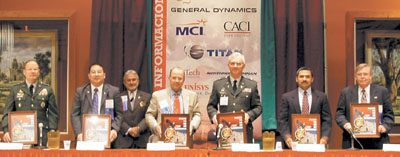 |
| Panelists for the Fiesta Informacion 2004 discussion on security issues are (foreground, l-r) moderator Lt. Gen. Keith Alexander, USA, deputy chief of staff, G-2, Headquarters Department of the Army; Donald Get, executive director, Air Intelligence Agency; Michael Waschull, director of intelligence and security, Missile Defense Agency; Brig. Gen. Daniel Perugini, USA, commander, Brooke Army Medical Center, Fort Sam Houston; Mel Mireles, director, enterprise operations, state of Texas Department of Information Resources; and Phil LaCombe, vice president of secure mission solutions, General Dynamics Advanced Information Systems. Alamo Chapter President and Fiesta Informacion 2004 General Chairman Jerry Lazaroff (in the background) presents tokens of appreciation to each of the panel members. |
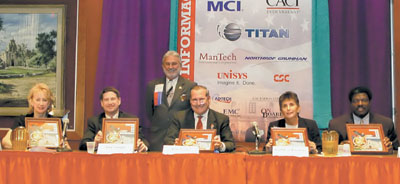 |
| Lazaroff (background) thanks panelists for their input on intergovernmental collaboration. They are (l-r) moderator Joan Dempsey, executive director of the President’s Foreign Intelligence Advisory Board; Tim Sample, vice president for strategy and business development, engineering development and integration services, General Dynamics Advanced Information Systems; Peter Verga, principal deputy assistant secretary of defense for homeland defense, U.S. Defense Department; Dr. Kathleen Kiernan, senior executive vice president, international law enforcement, MZM Incorporated; and Assistant Chief Jerry Pittman, San Antonio Police Department. |
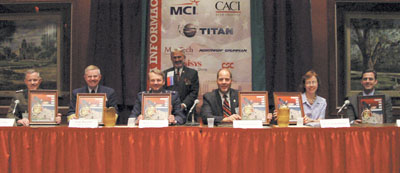 |
| Gathered at Fiesta Informacion to examine interoperability issues are, from the left, moderator Lt. Gen. Robert Shea, USMC, director, command, control, communications and computer systems, J-6, the Joint Staff; Vice Adm. Tom Barrett, USCG, vice commandant, U.S. Coast Guard; Maj. Gen. Dale Meyerrose, USAF, director, command and control systems, North American Aerospace Defense Command, and director, architectures and integration, Headquarters U.S. Northern Command; Michael Braun, deputy assistant administrator for intelligence, Drug Enforcement Administration; Evelyn DePalma, director, procurement and logistics, and chief, Defense Information Technology Contracting Organization, Defense Information Systems Agency; and Kevin Meiners, director, intelligence strategies, assessments and technology, Office of the Undersecretary of Defense for Intelligence. Lazaroff (background) thanks the panelists with a gift. |
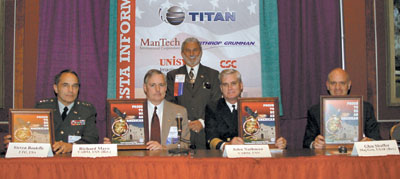 |
| At Fiesta Informacion, (l-r) Lt. Gen. Steven Boutelle, USA, chief information officer, G-6, U.S. Army; Vice Adm. Richard Mayo, USN (Ret.), senior vice president for strategic plans, CACI; Vice Adm. John Nathman, USN, deputy chief of naval operations, warfare requirement and programs, N-6/N-7, U.S. Navy; and Maj. Gen. Glenn Shaffer, USAF (Ret.), accept gifts from the chapter following their panel on integration. Lazaroff makes the gift presentations. |
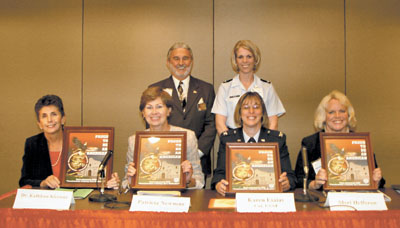 |
| 1st Lt. Danielle Pucci, USAF, and Lazaroff (back row) present speaker’s awards to the Practitioners’ Forum. The panel members are, from the left, Kiernan; Patricia Newman, executive assistant, Homeland Security Support Office, National Security Agency; Col. Karen Esaias, USAF, commander, 8th Field Investigations Region, U.S. Air Force Office of Special Investigations; Meri Hefferon, deputy assistant director, Department of Strategic Support, Naval Criminal Investigative Service. |
 |
| Alamo Chapter Board members Cinda Tapia (c), executive director of Fiesta Informacion, and Nancy Kudla, chairman and chief executive officer of dNovus RDI, welcome keynote speaker Gen. John Jumper, USAF, chief of staff, U.S. Air Force, to the symposium. |




Comments